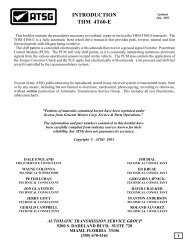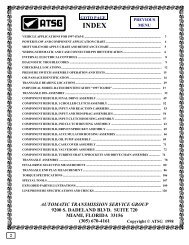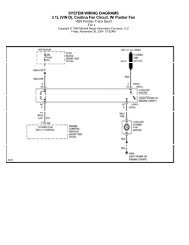Controls
Controls
Controls
You also want an ePaper? Increase the reach of your titles
YUMPU automatically turns print PDFs into web optimized ePapers that Google loves.
Seats & Restraint Systems<br />
How The Air Bag System<br />
Works (CONT.)<br />
What makes an air bag inflate?<br />
In a frontal impact of sufficient severity, the<br />
air bag sensing system detects that the<br />
vehicle is suddenly stopping as a result of a<br />
crash. The sensing system triggers a<br />
chemical reaction of the sodium azide<br />
sealed in the inflator. The reaction produces<br />
nitrogen gas, which inflates the cloth bag.<br />
The inflator, cloth bag, and related<br />
hardware are all part of the air bag inflator<br />
module packed inside the steering wheel.<br />
How does an air bag restrain?<br />
In moderate to severe frontal or<br />
near-frontal collisions, even belted<br />
occupants can contact the steering w rhee :l.<br />
The air bag supplements the protection<br />
provided by safety belts. Air bags<br />
distribute the force of the impact more<br />
evenly over the occupant’s upper body,<br />
stopping the occupant more gradually.<br />
But air bags would not provide protection<br />
in many types of collisions, including<br />
rollovers and rear and side impacts,<br />
primarily because an occupant’s motion is<br />
not toward the air bag. Air bags should<br />
never be regarded as anything more than<br />
a supplement to safety belt protection in<br />
moderate to severe frontal and<br />
near-frontal collisions.<br />
What will you see after an air bag<br />
inflation?<br />
After the air bag has inflated, it will then<br />
quickly deflate. This occurs so quickly<br />
that some people may not even realize<br />
that the air bag inflated. Some<br />
components of the air bag module in the<br />
steering wheel hub may be hot for a short<br />
time, but the portion of the bag that comes<br />
into contact with you will not be hot to<br />
the touch. There will be small amounts of<br />
smoke and dust coming from vents in the<br />
deflated air bag. The air bag will not<br />
impede the driver’s vision or ability to<br />
steer the vehicle, nor will it hinder the<br />
occupants from exiting the vehicle.<br />
0<br />
0<br />
0<br />
The air bag is designed to inflate only<br />
once. After it inflates, you’ll need<br />
some new parts for your air bag<br />
system. If you don’t get them, the air<br />
bag system won’t be there to help<br />
protect you in another crash. A new<br />
system will include the air bag module<br />
and possibly other parts. The service<br />
manual has information about the<br />
need to replace other parts.<br />
Your vehicle is equipped with a<br />
diagnostic module, which records<br />
information about the air bag system<br />
if the air bag deploys during a crash.<br />
The module records information about<br />
the readiness of the system, which<br />
sensors activated the deployment, and<br />
whether the driver’s safety belt was in<br />
use.<br />
Let only qualified technicians work on<br />
your air bag system. Improper service<br />
can mean that your air bag system<br />
won’t work properly. See your dealer<br />
for service.








